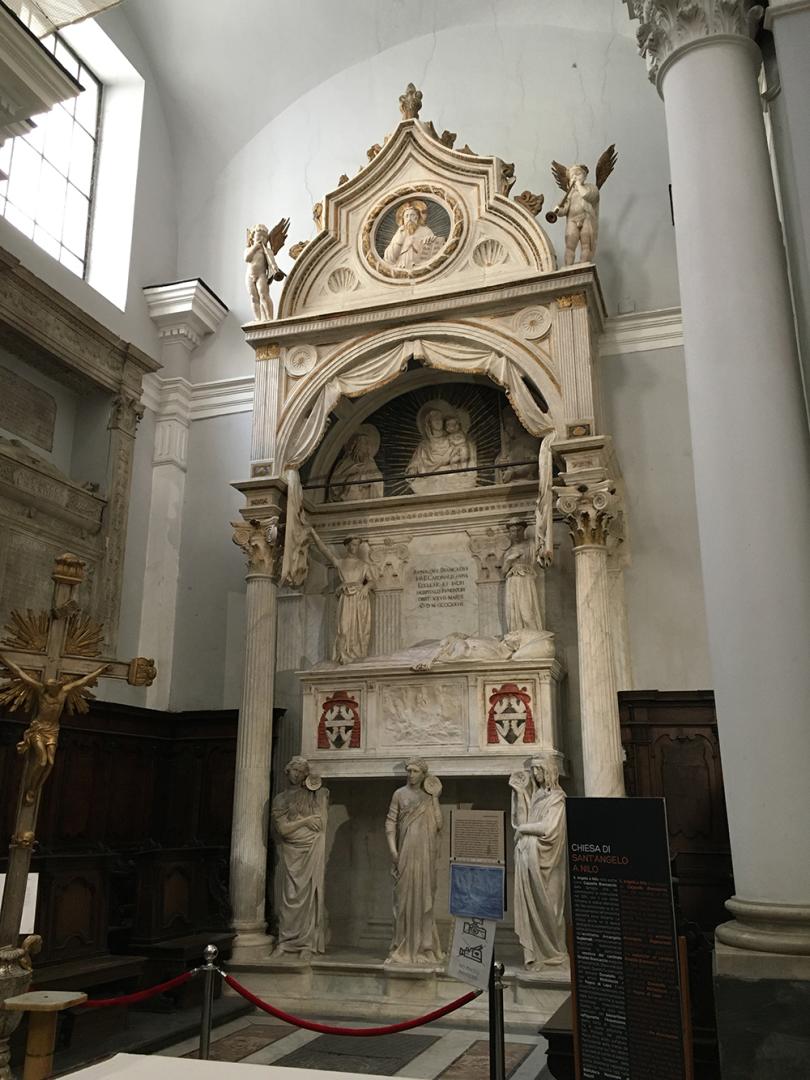In the crowded lower decumanus, more commonly known as Spaccanapoli, is the historic Piazzetta Nilo, the nerve centre of Greco-Roman Naples.

The building as a whole has two orders outwardly marked by fake columns with Corinthian capitals and is painted gray and red. The main entrance, located on via Mezzocannone, has the main portal dating back to the ancient Gothic construction. It consists of an architrave with half-relief figures of angels and saints, and there is also a fresco, which can be dated to the decades of the fifteenth century. The side façade, overlooking Piazza San Domenico Maggiore, houses another entrance, the one from which you enter the church. Around the portal we have two niches in which the marble statues of Santa Candida Seniore and Santa Candida Iuniore are housed, works by the sculptor Bartolomeo Granucci.
The interior has a single nave without a transept and consists of only two chapels and a sacristy. The stuccos, designed by Arcangelo Guglielmelli and made by Bartolomeo Granucci, decorate all the walls and depict emblems and sepulchral busts of members of the Brancaccio family.
The most interesting area of the church of Sant'Angelo a Nilo is the apse. Of particular importance is the sepulchral monument of Cardinal Rainaldo Brancaccio, a jewel of early Renaissance sculpture. Located to the right of the high altar, the work was created in Pisa by Donatello and Michelozzo di Bartolomeo between 1426 and 1428, and then sent to Naples by sea. Some assistants also took part in the enterprise, including the Tuscan master Pagno di Lapo Portigiani. The sepulcher is made of marble and is spread over several levels. What most strikes the observer's gaze is the sepulchral chest which, supported by three female figures (the Caryatids), presents the recumbent figure of the deceased, but above all a bas-relief depicting the Assumption of the Madonna created by Donatello. This Donatellian masterpiece was made with flatbread, a sculptural technique that allows for the creation of a slight protrusion from the bottom, creating an illusionistic effect of depth.
To the left of the main altar you can admire the sepulchral monument of cardinals Francesco and Stefano Brancaccio, created by the Carrara sculptors Bartolomeo and Pietro Ghetti. The work, with a pyramidal shape, has a clear Baroque layout and is rich in typically Bernini elements, a legacy of the formation of the Ghettos in the Roman sphere. The shape of the monument is very interesting thanks to a series of figurative elements, which culminate in the depiction of the military and cardinal trophies of the two members of the Brancaccio family. Of great interest are other elements such as the medallion in which the faces of the two cardinals are depicted, Virtue in the act of writing praises to the two characters, Fame and, above all, Death which appears in the form of a skeleton.
Finally, in the centre of the apse of the church there is the high altar by Arcangelo Guglielmelli, above which you can see the Archangel Michael, the work of the Mannerist painter Marco Pino.
Information:
open all week from 9 a.m. to 1 p.m. and 5:30 p.m. to 7:30 p.m.
free entry



Comments powered by CComment